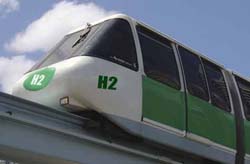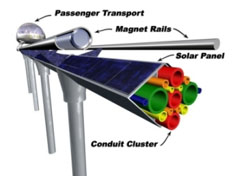HYDRAIL: PRELIMINARY PROPOSAL
This page undergo frequent updates
Project Approach Base
 There are a handful of HYDRAIL technology/solution providers in the world.
The utilization of Hydrogen Fuel Cell in a high speed 'bullet' train is relatively
a new innovation even though bullet train and fuel cell technologies
separately have existed a very long time on their own.
Japan is the first nation to test, construct and operate successfully
a Hydrail system. It began rolling out and commence operation only in mid 2006.
CAEDZ, LLC is looking beyond simply from the technology stand point: we look
for the best innovation from both the financial model and the comprehensiveness
of the infrastructure integration aspect. The transportation requirements
of the INITIATIVE must
demonstrate the ability to interconnect various other form of transportation
systems as well as with competing (similar) technologies. The CORRIDOR after all, is a very large living showroom that focuses on promoting all that
is clean, green and renewable.
As such, Caedz is working directly with principal technology providers and major multinational concessionaires
to develop and design a holistic approach to the integration of technologies
with financial model that can provide comprehensive and practical application
of everything that is clean, green, renewable and highly innovative transportation
solutions.
There are a handful of HYDRAIL technology/solution providers in the world.
The utilization of Hydrogen Fuel Cell in a high speed 'bullet' train is relatively
a new innovation even though bullet train and fuel cell technologies
separately have existed a very long time on their own.
Japan is the first nation to test, construct and operate successfully
a Hydrail system. It began rolling out and commence operation only in mid 2006.
CAEDZ, LLC is looking beyond simply from the technology stand point: we look
for the best innovation from both the financial model and the comprehensiveness
of the infrastructure integration aspect. The transportation requirements
of the INITIATIVE must
demonstrate the ability to interconnect various other form of transportation
systems as well as with competing (similar) technologies. The CORRIDOR after all, is a very large living showroom that focuses on promoting all that
is clean, green and renewable.
As such, Caedz is working directly with principal technology providers and major multinational concessionaires
to develop and design a holistic approach to the integration of technologies
with financial model that can provide comprehensive and practical application
of everything that is clean, green, renewable and highly innovative transportation
solutions.
Hydrogen Super High-speed Rail built for the CORRIDOR
While the CORRIDOR will have three new toll zero-emission (hydrogen) highway running parallel from Cirebon to Bandung, passing through Kertajati Aerocity, and another toll zero-emission (hydrogen) highway from Kertajati Aerocity to Jakarta, it will still be critical to lay and install a high speed bullet train system along the same destination and beyond to other major cities, including Jakarta, because of the major international airport located at Kertajati Aerocity. The new airport, which is currently under construction at Kertajati, is mandated to eventually serve more than 90 million passengers a year. This will require major public transportation to link to key and major cities in the island of Java. CAEDZ has selected a unique and innovative solution to meet the public transportation requirements of the CORRIDOR. This selection was expedited after the Indonesian Government approved to the construction of a high speed bullet train and posted the announcement of their decision and request for proposal on the national government's official website last March. The solution selected will fulfill the need to have a high speed train system and at the same time it will be a clean, green and renewable solution. A hydrogen bullet train will be installed to provide an integrated on-demand public transportation mesh with other real estate assets and public services on the CORRIDOR. The Hydrogen High-speed Rail Superhighway (H2RSH) system is based on the integration of Interstate Traveler's Hydrogen Superhighway technology with other components of the CORRIDOR's infrastructure and transportation systems. The unique approach and design of the Hydrogen Superhighway technology
from Interstate Traveler Company, particularly the utilization of Conduit
Cluster design (as shown in diagram on your left), introduces a business model befitting to the CORRIDOR's
overall design challenges and opportunities - an infrastructure that
enables and promotes the production and distribution of renewable energy
along a major transportation pathway and in so doing connects and integrates
communities along the pathway with no additional cost.
PHASE 1 of the Hydrogen High-speed Rail Super Highway (H2RSH) Project will connect Cirebon Seaport, at the east end of the rail track, passing and stopping at Kertajati Aerocity, 80 km directly west of Cirebon, Bandung, 100 km directly west of Kertajati, Central Jakarta, 160 km north west of Bandung, and ending at North Jakarta, 22 km north north west of Central Jakarta - a total of 357 km long. At an average speed of 288 km per hour
and an average of 1 minute stop at each station, the ITC H2RSH hydrogen
bullet train can take less than 1 hour and 30 minutes to travel from
end-to-end.
The unique approach and design of the Hydrogen Superhighway technology
from Interstate Traveler Company, particularly the utilization of Conduit
Cluster design (as shown in diagram on your left), introduces a business model befitting to the CORRIDOR's
overall design challenges and opportunities - an infrastructure that
enables and promotes the production and distribution of renewable energy
along a major transportation pathway and in so doing connects and integrates
communities along the pathway with no additional cost.
PHASE 1 of the Hydrogen High-speed Rail Super Highway (H2RSH) Project will connect Cirebon Seaport, at the east end of the rail track, passing and stopping at Kertajati Aerocity, 80 km directly west of Cirebon, Bandung, 100 km directly west of Kertajati, Central Jakarta, 160 km north west of Bandung, and ending at North Jakarta, 22 km north north west of Central Jakarta - a total of 357 km long. At an average speed of 288 km per hour
and an average of 1 minute stop at each station, the ITC H2RSH hydrogen
bullet train can take less than 1 hour and 30 minutes to travel from
end-to-end.  The H2RSH Phase 1 will comprise of 10 sets of four large transport and
one regular transport units or a total of 40 large size transport and
10 regular size transport units. The regular transport unit accommodate 100 commuters whilst the larger transport unit accommodate 200
commuters. The transports are scheduled at 10 minutes apart and runs 24
hours a day. Phase 1 of the H2RSH has a maximum capacity to shuttle 211,200 commuters per day.
The H2RSH Phase 1 will comprise of 10 sets of four large transport and
one regular transport units or a total of 40 large size transport and
10 regular size transport units. The regular transport unit accommodate 100 commuters whilst the larger transport unit accommodate 200
commuters. The transports are scheduled at 10 minutes apart and runs 24
hours a day. Phase 1 of the H2RSH has a maximum capacity to shuttle 211,200 commuters per day.
 With the rail track to cover a distance of 357 km
long, this provide a solar surface at ~ 22% efficient solar panels
would produce 376,780,800 watts/hour or 3.7 MW per day. Some of the
energy from the solar and water will produce hydrogen fuel, which in
turn will provide the fuel to operate the rail transport system. The
H2RSH rail transport system planned for the CORRIDOR will require less
than 1% of the energy required to operate the tranpsort carriages. The
surplus energy produced by the H2RSH system will be distributed to the
grid, providing cities along the bullet train track electricty and
hydrogen fuel supply.
Additional information on the Project H2RSH Indonesia:
With the rail track to cover a distance of 357 km
long, this provide a solar surface at ~ 22% efficient solar panels
would produce 376,780,800 watts/hour or 3.7 MW per day. Some of the
energy from the solar and water will produce hydrogen fuel, which in
turn will provide the fuel to operate the rail transport system. The
H2RSH rail transport system planned for the CORRIDOR will require less
than 1% of the energy required to operate the tranpsort carriages. The
surplus energy produced by the H2RSH system will be distributed to the
grid, providing cities along the bullet train track electricty and
hydrogen fuel supply.
Additional information on the Project H2RSH Indonesia:
| • Conduit Cluster Specifications | • Transport Unit Specifications | |
| • Terminal Station Design | • Route & Schedule |

